Choosing Product Photography Backdrops That Sell
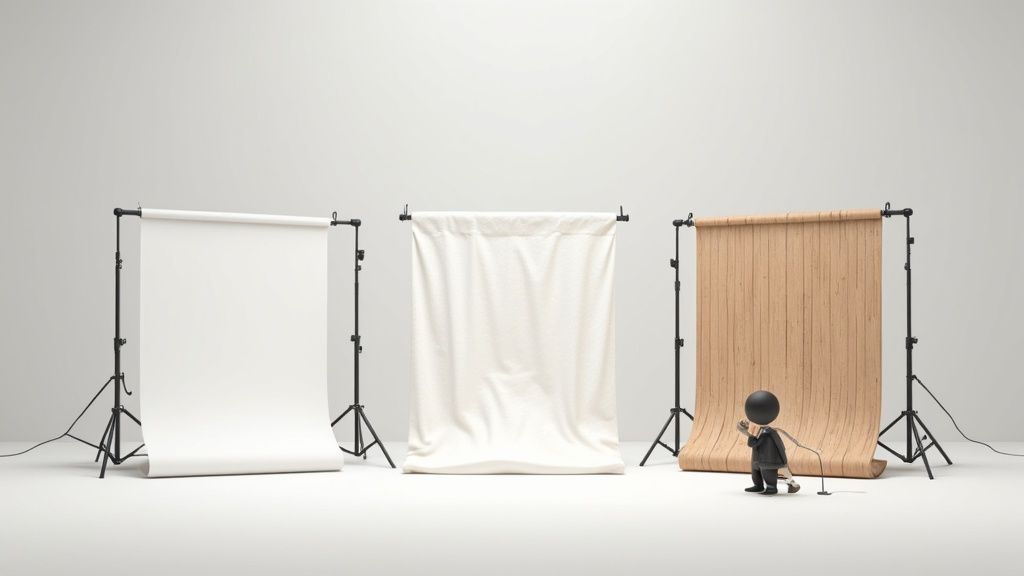
Your product photography backdrop is the unsung hero of your brand's visual story. It’s what sets the stage, creates a mood, and can make your product look absolutely irresistible. Think of it as more than just a background—it’s a powerful tool that frames your product, draws the customer’s eye, and communicates quality before they’ve even read a word.
Why Your Backdrop Is More Than Just a Background
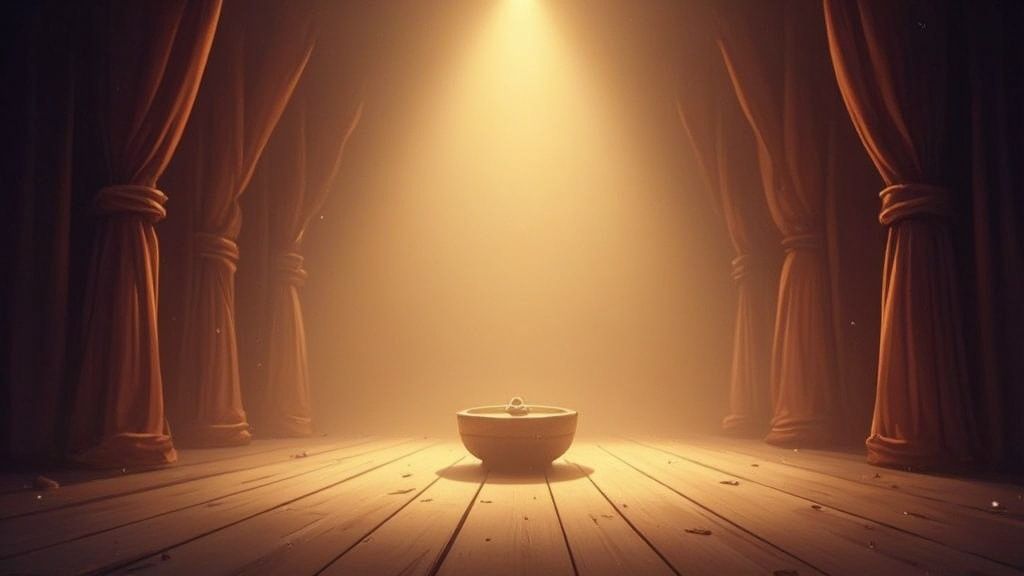
Imagine your product is the lead actor in a play. The backdrop is the set design. A bare stage under a single harsh spotlight tells a very different story than a thoughtfully lit set with rich textures. The right backdrop doesn't just sit behind your product; it elevates it, transforming a simple item into something a customer can truly envision in their life.
This is your first, and maybe best, chance to connect with a customer on an emotional level. It works quietly in the background, using color and texture to signal what your brand is all about. A rustic, reclaimed wood surface hints at craftsmanship and natural quality. On the other hand, a sleek, glossy acrylic sheet screams modern and high-tech.
The Psychology of Visual Cues
Never underestimate the psychological impact of the textures and colors you use. They can make a product feel luxurious, organic, playful, or professional. This is especially vital in e-commerce, where a customer can't physically hold the item. Your backdrop has to provide the sensory context they’re missing.
Here’s how it works in practice:
- Soft linen or fabric can suggest comfort and quality, a perfect match for textiles or handmade goods.
- A solid, neutral color creates a clean, distraction-free canvas that puts all the attention on the product's details, which is ideal for electronics or minimalist brands.
- A marble or stone texture adds a sense of weight, elegance, and premium quality, which is why you see it so often with cosmetics and jewelry.
Your backdrop is the visual anchor that holds your brand's story together. It’s the difference between showing someone a product and selling them a feeling.
Framing the Star of the Show
A great backdrop makes sure your product is the undeniable hero of the shot. It should never compete for attention. Instead, it creates a harmonious scene that guides the viewer’s eye exactly where you want it to go. This single decision can shape how a customer perceives your product and, ultimately, whether they decide to buy.
As online shopping has exploded, the demand for professional-looking backdrops has skyrocketed. That’s no surprise when you consider that 65% of consumers are visual learners and that good images can increase content views by a staggering 94%. This makes choosing the right backdrop a critical, yet often overlooked, part of creating images that actually convert. And for those just starting out, exploring options for affordable product photography can deliver fantastic results without breaking the bank.
An Essential Guide to Backdrop Materials
Picking the right material for your product photography backdrop is a lot like a chef choosing the perfect plate—it has to complement the main dish without stealing the show. Every material brings its own unique texture, finish, and workflow to the table, and that choice directly shapes the final look and feel of your images. If you understand the practical differences, you can solve common photography headaches before you even start shooting.
Think about it: some surfaces soak up light beautifully, killing harsh reflections on shiny products. Others are built to handle spills and splatters, making them a lifesaver for food or cosmetic shoots. Let’s break down the most popular options to find the best fit for you.
Seamless Paper: The Industry Workhorse
If you walk into most photo studios, you'll find rolls of seamless paper. It’s easily the most common and versatile material out there. It comes in huge rolls of every color imaginable and gives you a perfectly smooth, non-reflective surface for clean, distraction-free shots.
The biggest win here is consistency. If the paper gets dirty or scuffed up, you just tear off the used part and roll down a fresh, clean section. This makes it incredibly efficient for high-volume e-commerce work where every product needs that same uniform background.
Seamless paper offers a flawless, crease-free finish that puts the entire focus on your product. It’s the go-to choice for achieving that classic, professional look seen on major retail websites.
This infographic breaks down how to match the right surface to your specific product needs.
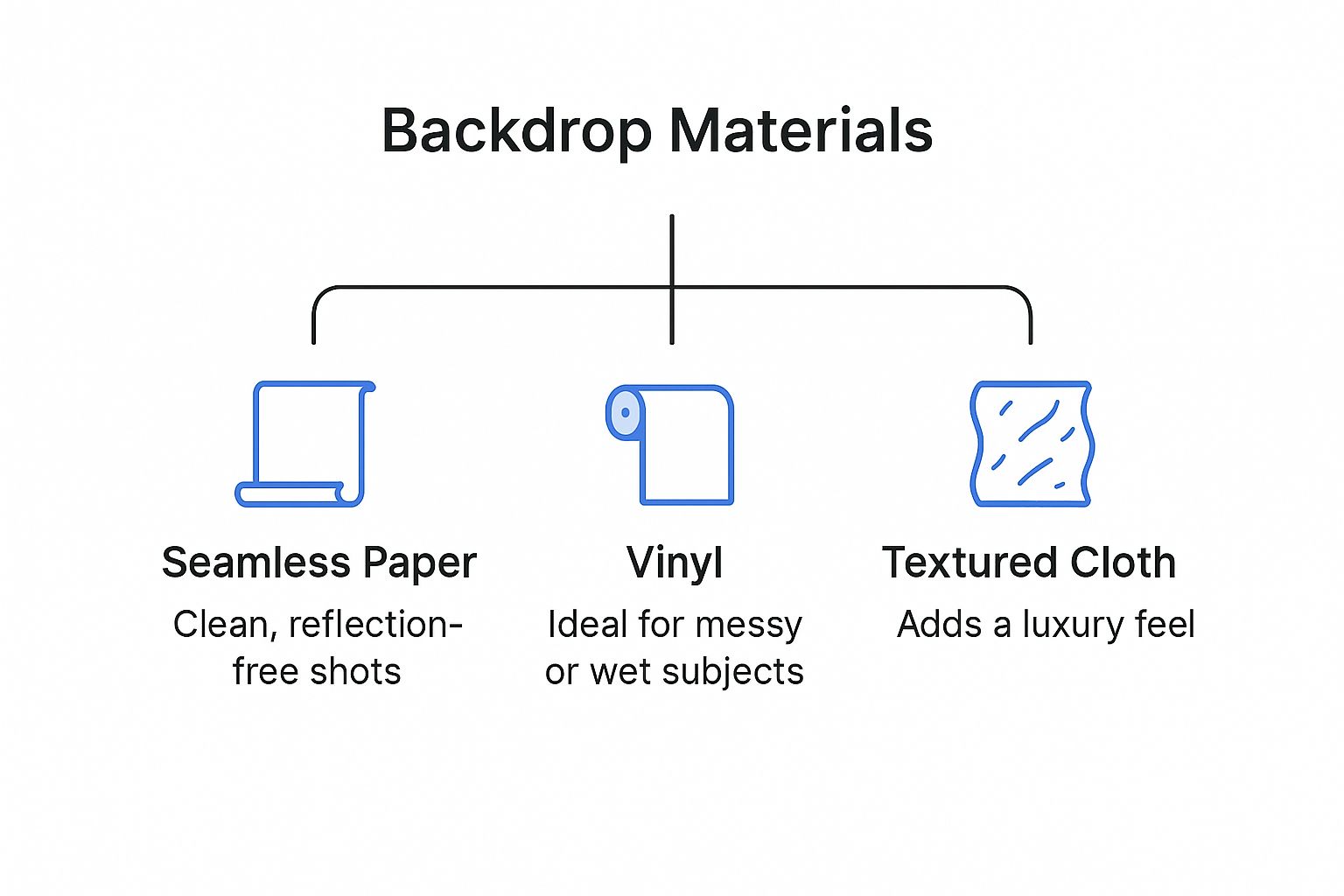
As you can see, each material really does have its own job, from the clean utility of seamless paper to the rugged functionality of vinyl and the rich textures of cloth.
Vinyl: The Durable and Reusable Solution
For anyone shooting messy subjects—think food, liquids, or cosmetics—vinyl backdrops are an absolute game-changer. Unlike paper, vinyl is non-porous and incredibly tough. You can just wipe it clean after a shoot and use it again and again, which makes it a smart, cost-effective option over the long haul.
Vinyl also comes in a massive variety of printed textures. You can get realistic wood grains, marble patterns, concrete, and even metal effects. This lets you create a specific mood or lifestyle scene without having to lug around heavy, expensive props. The only thing to watch out for is potential glare; its slightly reflective surface sometimes requires careful light positioning to avoid hotspots.
Cloth and Fabric for Texture and Elegance
Cloth backdrops, like canvas, muslin, or linen, introduce a softness and texture that other materials just can't match. They’re fantastic for creating a more artistic, moody, or luxurious atmosphere. Canvas, in particular, is often hand-painted, giving you unique, one-of-a-kind patterns that make your photos pop.
The downside? Fabrics love to wrinkle. You'll almost always need to steam or stretch the material taut on a frame to get a smooth look. But that same quality also offers creative freedom—their ability to drape and fold can add beautiful dimension and depth to a scene.
Wood, Tile, and Other Rigid Surfaces
When you need pure realism, nothing beats the real thing. Using actual wood planks, slate tiles, or metal sheets as a backdrop provides authentic textures that are almost impossible to fake. These are brilliant for flat-lay photography, especially for food, artisan goods, or products with a rustic vibe.
The trade-off, of course, is practicality. These materials are often heavy, a pain to store, and way less versatile than a simple roll-up backdrop. Still, for a brand that built its identity on natural or handcrafted quality, the authenticity they bring is priceless.
To help you weigh the options, here’s a quick comparison of the most common materials.
Backdrop Material Comparison Guide
| Material | Durability | Best For | Pros | Cons |
|---|---|---|---|---|
| Seamless Paper | Low (disposable) | E-commerce, portraits, clean looks | Flawless surface, wide color variety, affordable | Easily damaged, not reusable |
| Vinyl | High (reusable) | Food, cosmetics, textured flat lays | Wipeable, durable, huge pattern variety | Can create glare, may look less authentic |
| Cloth/Fabric | Medium | Moody product shots, fashion, lifestyle | Rich texture, elegant, non-reflective | Wrinkles easily, needs maintenance |
| Rigid Surfaces | Very High | Ultimate realism, food, rustic themes | Authentic texture, very durable | Heavy, difficult to store, less versatile |
Ultimately, the right material depends entirely on the story you're trying to tell with your product.
In today's digital-first retail world, this kind of versatility is key. While 80% of major e-commerce listings still lean on clean white backgrounds for basic product shots, textured and colored backdrops are quickly gaining ground. These lifestyle-focused options are especially hot in the fashion and home decor markets, which now make up over 30% of backdrop sales in Western Europe and North America. You can even branch out into post-production magic by exploring specific backdrop materials like green screens to digitally swap in any background you can imagine.
Choosing a Backdrop That Aligns With Your Brand
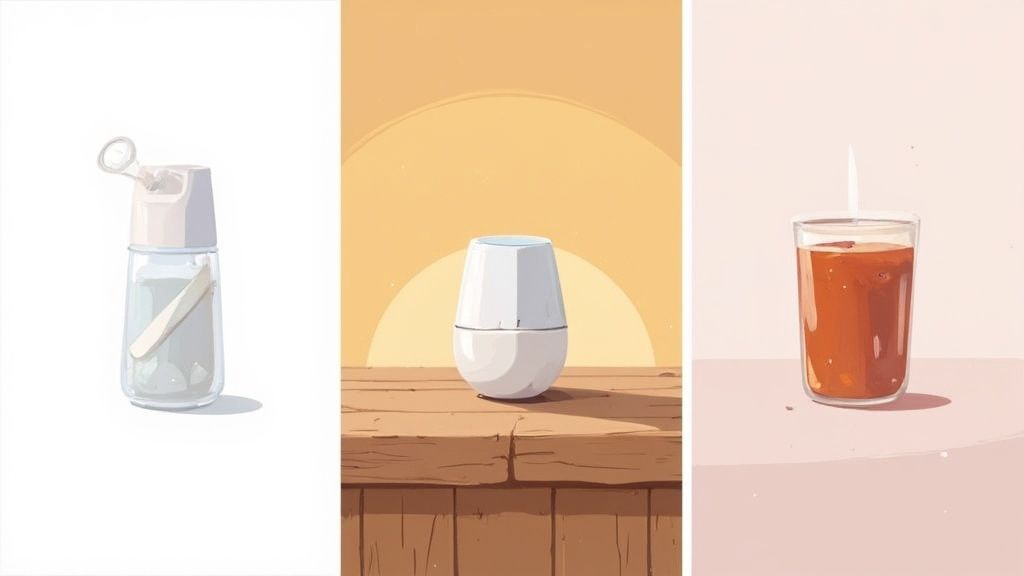
Alright, you've got a handle on the different materials. Now comes the fun part: thinking like a brand strategist. The best backdrops do more than just look pretty—they’re an active part of your sales team, reinforcing your brand’s identity and speaking directly to your ideal customer.
Every choice you make, from the color to the texture, sends a powerful message. It tells a story about your product’s quality, its personality, and its place in the world.
Think about it. You wouldn't photograph a sleek, futuristic gadget on a rough slab of barn wood, would you? It creates a jarring disconnect. In the same way, a jar of organic, farm-to-table honey would look completely out of place on a cold, sterile metal sheet. Your backdrop needs to feel like a natural extension of your brand story.
Color Psychology in Product Photography
Color is your shortcut to emotion. It’s the very first thing a shopper’s brain registers, and it can instantly shape how they feel about your product. Picking the right color isn't just about what looks good; it's a strategic move to make your product the hero.
A clean, minimalist white backdrop, for example, is a timeless classic for a reason. It screams simplicity, clarity, and modernity. This makes it a perfect partner for tech brands, skincare lines, and any product where the tiny details need to pop.
On the flip side, warm earth tones—think beige, terracotta, or soft browns—can create a feeling of comfort, nature, and authenticity. This is a go-to for handmade goods, wellness products, or anything with an artisanal vibe.
Your backdrop is a silent salesperson. A study of the top 100 global brands revealed that 95% use only one or two colors in their branding to maintain consistency and strengthen brand recall. The colors in your photos should align with this core identity.
These visual strategies are about more than just aesthetics; they're a key piece of the puzzle. When you understand how great visuals work with other elements, you can improve your ecommerce conversion rates across the board.
Texture and Style That Speak Volumes
If color sets the mood, texture communicates quality without a single word. A perfectly smooth, matte surface can suggest modern efficiency, while a rough, organic texture like slate or wood grain implies something is authentic, rustic, and built to last.
The texture should echo the tactile experience you want customers to imagine.
Let's break it down by brand personality:
- For the Luxury Brand: Go for elegance with materials like marble, rich velvet, or silk. The subtle sheen and luxurious feel instantly elevate high-end items like jewelry, perfume, or premium leather goods.
- For the Natural and Organic Brand: Think grounded and eco-friendly. Unfinished wood, stone, linen, or even props like moss and leaves are perfect for artisanal foods, natural cosmetics, or handcrafted home goods.
- For the Playful and Bold Brand: Embrace color! Bright, solid-colored backdrops or simple geometric patterns radiate energy and fun. This is a fantastic approach for kids’ toys, vibrant accessories, or any brand with a youthful, energetic personality.
A Practical Checklist for Your Backdrop Choice
Before you pull the trigger on a new backdrop, take a second to run through this mental checklist. It helps ensure your choice is a strategic one, not just a shot in the dark. Getting this right pays dividends in every photo you take.
- Does this match my brand's voice? (e.g., modern, rustic, elegant, playful?)
- Does the color make my product shine, or does it fight for attention? (When in doubt, use a color wheel to find complementary or analogous pairings.)
- Will this texture enhance my product or distract from it? (A busy texture can easily overwhelm a simple product.)
- Is this something my target customer would find appealing?
- Can I use this consistently across my entire product line?
Answering these questions shifts your thinking from just picking a background to building a powerful and cohesive visual brand. The right backdrop doesn't just display your product—it sells the entire experience.
How to Set Up Your Backdrop Like a Pro
Having a great backdrop is a fantastic start, but it's only half the battle. The real magic, the thing that separates the pros from the amateurs, happens in the setup. A sloppy, wrinkled, or poorly lit backdrop can make even the most beautiful product look cheap. Your goal is to create a seamless, professional stage that lets your product shine, and that all comes down to a few key pieces of gear and a solid, repeatable process.
Think of your setup as the foundation of your photoshoot. If the foundation of a house is crooked, everything you build on top of it will be off. Taking the time to properly hang, smooth, and light your backdrop will save you countless hours of tedious editing later and ensure your final image looks polished and distraction-free.
The Essential Gear for a Flawless Setup
You don’t need a massive studio budget to get professional-looking results. In fact, a few reliable pieces of equipment will give you all the control and consistency you need for almost any product shoot. This small investment pays for itself almost immediately in better workflow and higher-quality images.
Here’s the basic kit I recommend for everyone:
- Backdrop Stand: For paper, vinyl, or cloth rolls, this is non-negotiable. A sturdy, adjustable stand lets you set the perfect height and width for your scene and, most importantly, keeps the backdrop secure.
- Clamps and Grips: These are your best friends on set. Often called A-clamps, they are perfect for pulling a backdrop taut to kill wrinkles and for securing it to the stand, a table, or just about any other surface.
- Gaffer Tape: This is not duct tape. Gaffer tape has a powerful hold but peels off cleanly, leaving zero sticky residue behind. It's the industry standard for taping down the edge of a paper sweep to the floor without causing damage.
With just these three things, you can handle almost any type of backdrop material and make sure it looks pristine in every single shot.
Achieving a Smooth, Wrinkle-Free Surface
Creases and wrinkles are public enemy number one for a clean backdrop. They create distracting lines and catch light in weird ways, pulling focus away from your product. The right technique for getting a smooth surface really depends on the material you're working with.
For seamless paper or vinyl, the "infinity sweep" is the way to go. You simply unroll the backdrop from its stand, letting it curve gently from the vertical part down onto your shooting surface or the floor. This creates a seamless horizon, making the product look like it's floating in a clean, endless space. A few clamps on the sides and a strip of gaffer tape on the floor will keep it perfectly smooth.
Cloth backdrops, on the other hand, require a little more prep. Before your shoot, take a few minutes to run a steamer or a low-heat iron over the fabric to get rid of any stubborn wrinkles from storage. When you hang it, pull it taut on all sides with your clamps to create a perfectly flat, even surface.
A classic beginner mistake is lighting the product and the backdrop with the same light. For real depth, light your product first. Then, add a separate, less powerful light aimed just at the backdrop. This gives you total control over the background's brightness and kills any unwanted shadows.
This kind of careful preparation makes a world of difference. To see how this fits into a larger strategy, you can explore our detailed guide on how to take professional product photos.
Lighting Your Backdrop for Different Effects
The way you light your backdrop completely changes the mood and style of your final image. You're not just trying to make the background visible; you're actively controlling how it looks to serve the product.
Creating a Pure White Background
This clean, crisp look is a hard requirement for many e-commerce platforms like Amazon. To pull it off, you have to light the backdrop separately from your product and actually make it brighter.
- First, position your main lights to get the perfect illumination on your product.
- Next, place one or two additional lights behind the product, aimed only at the white backdrop.
- Crank up the power on these background lights until the backdrop is roughly one f-stop brighter than your subject. This effectively "blows out" the background to pure white without overexposing your actual product.
Creating a Moody, Dark Background
For a more dramatic, high-contrast vibe, you do the exact opposite: you stop light from ever hitting the backdrop.
- Start with a dark-colored backdrop—gray or black works best.
- Move your product and your main light source as far away from the backdrop as you can. Distance is your friend here.
- Use what we call "flags" (just black cards or foam board) or a grid on your light to block any stray light from spilling onto the background.
This technique, known as "negative fill," essentially absorbs light and creates rich, deep shadows for a sophisticated and moody feel.
Creative and Sustainable DIY Backdrop Ideas
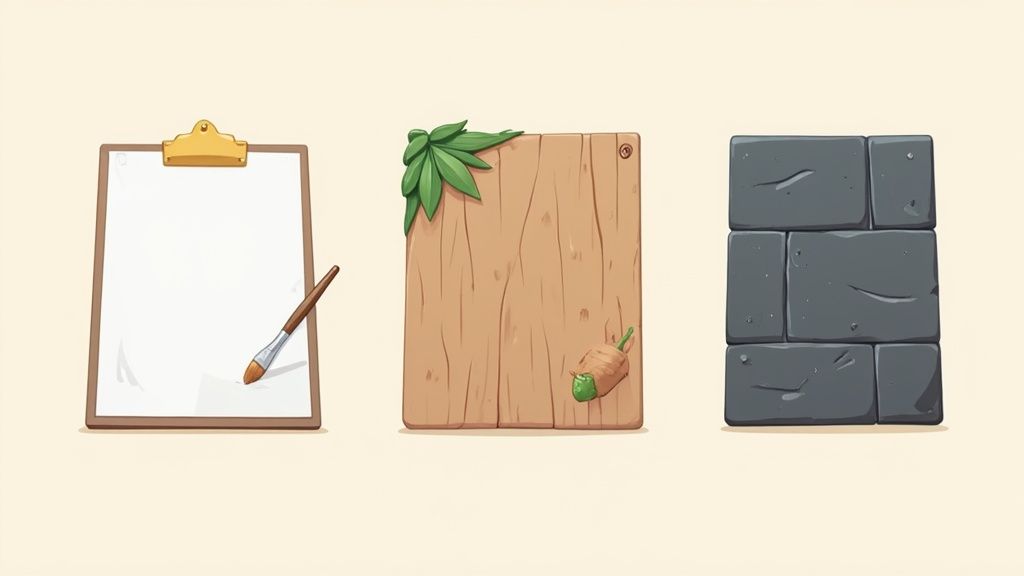
You don't need a massive budget to create stunning, one-of-a-kind backdrops. With a little imagination and some accessible materials, you can craft high-end looks that perfectly capture your brand’s unique personality. This approach is not only easy on the wallet but also gives you complete creative control over every texture, color, and mood in your photos.
Going the DIY route lets you experiment with surfaces you just can't buy off the shelf. Think of it as custom-designing the stage for your product, making sure every detail aligns with the story you want to tell. The possibilities are truly endless.
Accessible and Affordable DIY Solutions
Getting started with do-it-yourself backdrops is surprisingly simple. In fact, many of the most effective materials are probably waiting for you at a local hardware or craft store for just a few dollars. These little projects are perfect for adding variety to your shoots without a big upfront investment.
Here are a few of my favorite, easy-to-pull-off ideas:
- Painted Foam Boards: A plain white foam board is your blank canvas. Grab a few sample pots of matte or eggshell paint to create custom solid-color backgrounds that match your brand palette. You can even find textured spray paints to mimic the look of stone or concrete.
- Contact Paper Magic: Love the look of marble, wood, or granite but not the weight or cost? Self-adhesive contact paper is the answer. Just apply it to a rigid surface like a foam board or a spare piece of plywood for an instant, surprisingly realistic backdrop.
- Unique Fabric Finds: Swing by a fabric store and browse the remnants bin. A small piece of linen, velvet, or burlap can add beautiful texture and softness, which works especially well for jewelry, cosmetics, or handmade goods.
If you’re looking to build out a more complete home studio, our guide to a DIY product photography setup has more tips to help you put all the pieces together.
Embracing Sustainability in Your Backdrops
Beyond just saving a few bucks, creating your own backdrops is a fantastic way to make an eco-conscious choice. Sustainability is a big deal in the photography world right now, and for good reason. It’s a trend driven by a real consumer demand for environmental responsibility.
In fact, major e-commerce platforms often recommend using lifestyle and still-life product shots—the kind that look great on sustainable backdrops—because they can lead to higher conversion rates. It’s a clear sign that today, sustainability isn’t just a nice-to-have; it’s a global expectation.
By using reclaimed or natural materials, you infuse your brand’s story with authenticity and a commitment to sustainability—a message that resonates deeply with modern consumers.
Eco-Friendly Materials to Consider
Sourcing sustainable materials challenges you to think creatively, often resulting in truly unique textures that tell a story all their own. Instead of buying new, see what you can find to repurpose.
- Reclaimed Wood: Old fence posts, pallet wood, or discarded shelves can be sanded down and sealed to create beautifully rustic surfaces with genuine character.
- Slate Tiles or Stone Remnants: Give local flooring or countertop installers a call and ask if they have any leftover pieces. A single slate tile makes a fantastic moody, textured backdrop for food or skincare products.
- Recycled Paper and Cardboard: You can create a custom textured surface by layering torn pieces of recycled paper or cardboard with glue and then painting it a solid color. The result is a subtle, organic texture that adds incredible depth.
Common Questions About Product Backdrops
Even with the best gear and a solid plan, you're bound to run into a few snags with your product photography backdrops. It happens to everyone. Getting past these common hurdles is often the last step toward nailing that professional look every single time.
Let's walk through some of the questions I hear most often. Getting these answers down will save you a ton of frustration and editing time later on.
What Is the Best All-Around Color for a Backdrop?
If you're only going to buy one backdrop, make it neutral gray. I know, white seems like the obvious e-commerce choice, but gray gives you so much more creative wiggle room.
You can blast a light gray backdrop with light until it looks almost pure white. Or, you can underexpose a darker gray until it's nearly black. This means you can get a huge range of tones from a single roll, which is a massive win if you're shooting different kinds of products. It gives you that clean, polished look without being as stark as pure white or black can sometimes be.
How Do I Get a Pure White Background In-Camera?
Getting that perfect, "blown-out" white background straight out of the camera is all about lighting the backdrop separately from your product. The trick is to make the background much brighter than your subject, turning it into a pure white canvas (RGB 255, 255, 255) without washing out the product itself.
Here’s a simple way to approach it:
- Light the Product First: Forget the background for a second. Get the lighting on your product looking exactly how you want it.
- Add Background Lights: Now, place one or two lights behind your product, pointing them only at the white backdrop.
- Crank Up the Power: Turn up the background lights until your light meter shows they're about one to two stops brighter than the light hitting your product.
This separation is everything. It puts you in complete control, keeping your product crisp and detailed while the background vanishes into a flawless field of white.
What Is the Best Way to Prevent Wrinkles and Creases?
Wrinkles are the enemy of clean product shots. The battle starts with how you store and set up your gear. Always store seamless paper and vinyl rolls standing up vertically—this stops gravity from creating flat spots and creases. When you're setting up, use clamps on the sides of your stand to pull everything taut.
Got a fabric backdrop? A handheld steamer will be your new best friend. A quick pass before you start shooting will make any wrinkles from storage disappear.
So many people make the mistake of not pulling their backdrop tight enough. I always use A-clamps on the stand's crossbar and even gaffer tape on the floor to secure a paper sweep. That tension is what gives you the perfectly smooth, professional curve you see in high-end photos.
Can I Use a Green Screen for Product Photography?
Absolutely, but it’s a specific tool for a specific job. A green screen lets you use a technique called chroma keying to digitally remove the background in post-production and drop in any image or color you can imagine.
It’s incredibly powerful for creating wild composite images or placing a product in an environment you could never shoot in real life. That said, for most standard e-commerce photos, a physical white or gray backdrop is usually faster and gives you more natural-looking shadows right from the start.
Ready to skip the setup and get perfect product photos every time? QuickPixel uses AI to transform your simple product pictures into studio-quality images with flawless backgrounds. Get started today at https://quickpixel.co.
Try QuickPixel Today
Get started with our AI-powered image generation tools